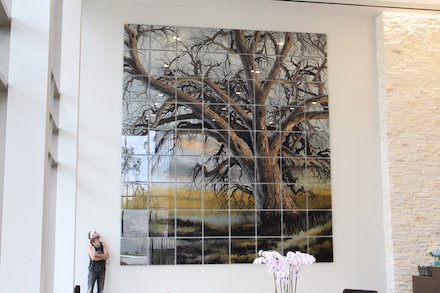“I experienced the most transcendent oneness I had ever felt.”
by Emily Jaeger, Features Editor

Christopher Owen Nelson, a painter, musician, and sculptor native to Colorado, studied Fine Arts at the Rocky Mountain College of Art and Design. Nelson’s artwork has been been featured in Western Art Collector; Luxe Interiors and Design; Western Art and Architecture; Santa Fean magazine, and American Art Collector. His solo exhibits include the Boulder Museum of Art, Boulder, Colorado; The Art Museum at the University of Kentucky, Lexington, Kentucky, and St. John’s College, Annapolis, Maryland. Corporate and public art collections include Wisdom Tree Investments, New York, New York; Rocky Mountain Cancer Center, Boulder, Colorado; Distant Cellars Vineyard, Fiddletown, California; Goodwill Industries; and Ritz Carlton.
The first thought that comes to mind when viewing one of Christopher Owen Nelson’s colossal, smooth, and shiny tree portraits or cracked-open, gigantic geodes is “How did he do that?” Nelson, whose cast-acrylic tree portraits are featured in April’s issue of The Woven Tale Press, brings together technical aplomb from years on the job in construction and a deep, emotional connection to his surroundings to “represent the simple parts of life that are so important.”

Nelson creates his signature shiny pieces by working mainly in acrylic—not the paint—but rather, sheets of acrylic which he carves in relief (and even melts) then paints into. All the manipulation of the acrylic sheets is done on the backside: “the end result is a smooth shiny facade.” Paintings cast in resin can also include a collage of textiles and letters that he writes to his subjects, whether trees or people.
While in some cases, a shiny facade might signify distance, in Nelson’s work, the shiny finish seems to magnify the emotion: the loving attention he pays to the exact details in a tree’s bark, the nuances of red skies, or, in his portraits, the appreciation for infinite individual variations. Like amber, which turns the overlooked ant or dust particle into a valuable gem, the acrylic layers remind the viewer “that something that looks so plain and ordinary on the surface,”—such as a tree—“could be filled with such incredible beauty.”

Indeed, Nelson’s love for and connection with the simple beauties of nature is the inspiration for much of his art:
I spend a majority of my time outdoors, particularly in a few area where I like to fish and walk my dogs…The environment puts me in a state of meditation, which for me is normal, but now suddenly i am beginning to notice life…[I am] absorbing information from the water and the trees in such a way that it makes me feel connected and attached. My growing familiarity with every minute detail challenges me to appreciate these sanctuaries as relatives, rather than place I simply walk or drive past.”

Although the tree portraits are emotional in focus, Nelson’s more recent series Objects delves into a political discussion of preserving the environment: “my goal is for the viewer to feel as though they are looking at something fossilized or from another time, while addressing environmental topics such as deforestation, overpopulation, and waste.” Nelson’s geodes, sculpted from cast dichroic glass and concrete, are molded into perfect geometric shapes: spheres or rectangular prisms. In addition to merely the stunning beauty of these pieces, the geometric shapes suggest humans’ attempts to control or manipulate the environment. Recreations of petrified wood hint at both past and future deforestation.

Another interesting series is Expanse. Here, abstractions in sanded and painted acrylic canvases are reminiscent of a Rothko painting. The movements of color and texture suggest the flowing fabric and the backgrounds from many of the trees and portraits These abstractions seem intimately related to his earlier, more representational pieces, allowing for the connectivity of artist and environment to take center stage—free of a specific subject. Nelson writes:
I was floating in what felt like outer space. I was not in my earthly body, but existed only in spirit. But it was the form of this existence that impacted me. I saw every person I loved and had ever known, I saw all of the places I had been, and they were all part of what felt like one greater spirit, that existed without form. Not as if we were being held together by something, but that we actually were the same being. Everyone was everything, and every place was every time. All thoughts, ideas, people, places, eras, were all one expanse of atmosphere. Everything was love. I experienced the most transcendent oneness I had ever felt.”

Copyright 2017 Woven Tale Press LLC. All Rights Reserved.

